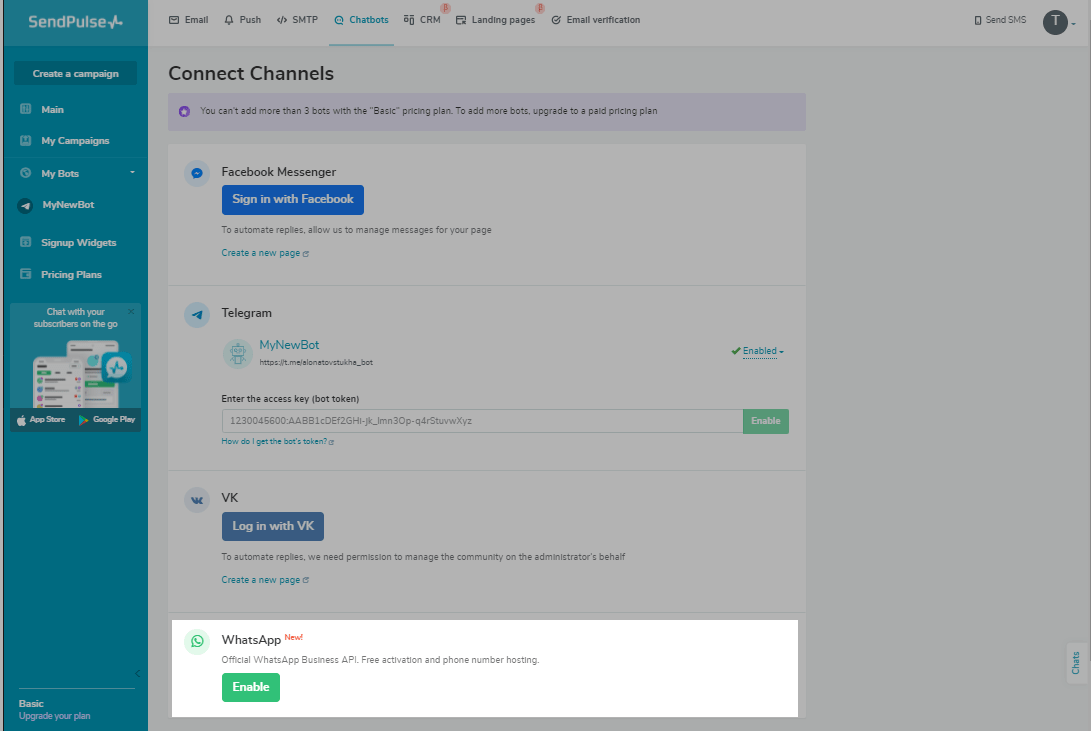How to configure SendPulse integration with Jivosite chat
Jivosite provides a tool for communicating with customers via website live chat, callbacks, messengers, apps, and email. The service also gives you the ability to accept payments in chat and connect your CRM.
With SendPulse and Jivosite integration, you will be able to work with customer requests from WhatsApp in the Jivosite application. The Jivosite chat widget will additionally display the option to send a message via WhatsApp on the website.
Create a WhatsApp chatbot with SendPulse
Go to the Chatbots section of your SendPulse account. Under the WhatsApp channel, click Connect.

Click Continue through Facebook and log in to the Facebook account you used to create your Facebook business account.
Next, follow the guide in the three-step account setup wizard to create a WhatsApp chatbot.
Read more about How to create a WhatsApp chatbot.

In order for the WhatsApp chatbot to work in full-featured mode, you need to verify your company on Facebook. Read more in the article How to validate a company in Facebook Business Manager.
Connect Jivosite to SendPulse
Select the desired chatbot and click Bot settings.

From the b tab, select Connect next to the Jivosite app.

In the login form that appears, specify the login and password for your Jivosite account with administrator rights.
After a few minutes, this channel will be added automatically to the Jivosite app.
You can go to the Administration section, to the Channels tab, and assign team members who will receive and answer incoming calls.

Set up messages
To manage chat settings, go to the Contact center section and open any chat in the desired channel.

What types of messages are available?
With the WhatsApp Business API, you can send two types of messages:
| Free messages (in Jivosite they are called "Session messages") | Messages that the operator can send in response to a client's request within 24 hours after the last message from the client. After 24 hours, only "Template messages" can be sent. |
| Template messages |
Transactional and trigger messages that have passed Facebook moderation. Templates are used for informing users about all changes that take place with their orders or account. Template messages must first be added via SendPulse, get approval from Facebook, and then added to Jivosite. The messages in Jivosite must be identical to those added via SendPulse. |
How to add a template to SendPulse
Select the WhatsApp chatbot you want to use, and go to Templates.
Click Add Template to create a new template, or click on an example template name from the list to edit an existing one.

Enter or edit the template’s content. Read more in the article How to add a template for WhatsApp campaigns.
Note that variables in the template must be added as numbers: {{1}}, {{2}}.
Also, buttons and images are not supported in Jivosite.
Then, click Add Template.
After you have added a template, it will be sent for moderation. You can check the status of the template in the Templates tab.
How to add a template in Jivosite
Open Jivosite and navigate to any chat room or open one of the archives. Click \ .. at the bottom of the text entry field.

In the Add Phrase window, click Add Phrase.

Copy the message text from the confirmed template into SendPulse and paste it into Jivosite unchanged.
Add a shortcut name to help you quickly find the template later. You can also optionally set a shortcut to send the phrase instantly.
Click Add.

Send a message
Go to Chats and select a chat with the desired user.
To send a free message, enter the text in the box and click Send.

To send a template message, in the message input field, press \ ..., select the template by label name, and click on the message text.

If you have a template with variables, instead of variables, insert their values and click Send.

Last Updated: 07.10.2024
or